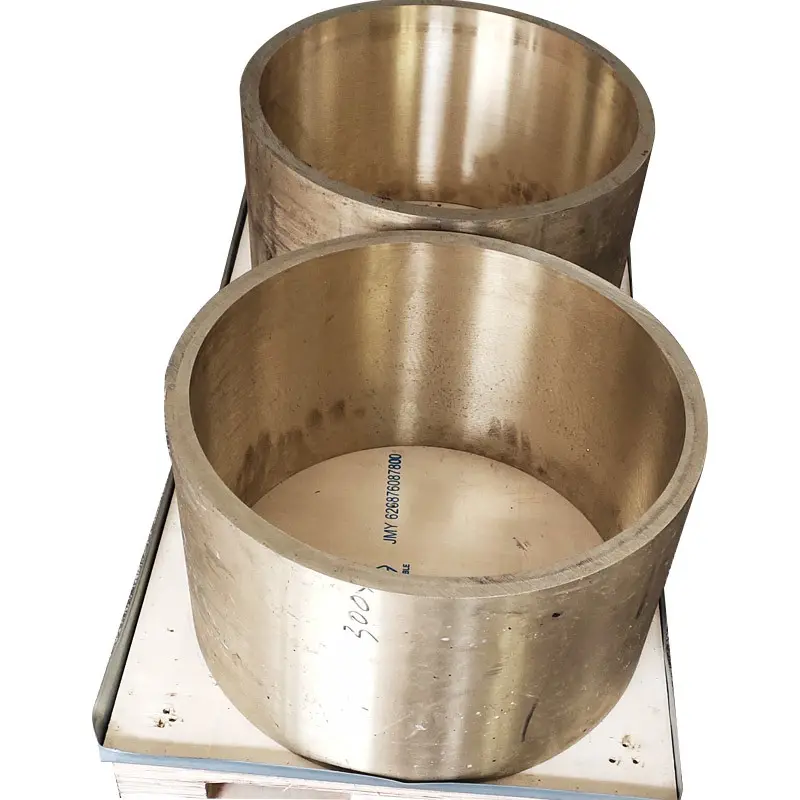
В судостроительной промышленности выбор правильного материала для производства винта имеет решающее значение для обеспечения оптимальной производительности, долговечности и эффективности. Среди различных доступных материалов алюминиевая бронза стала популярным выбором из -за превосходного сочетания прочности, коррозионной стойкости и механизма. Тем не менее, не все алюминиевые бронзовые оценки создаются равными, когда дело доходит до производства винта. Эта статья направлена на изучение различных сортов алюминиевой бронзы и определить, что лучше всего подходит для морских пропеллеров.
Понимание алюминиевой бронзы
Алюминиевая бронза-это семейство сплавов на основе меди, которые содержат алюминий в качестве основного сплавного элемента, часто с дополнительными элементами, такими как железо, никель и марганец. Эти сплавы известны своей высокой прочностью, превосходной коррозионной устойчивостью (особенно в морской воде) и хорошей износостойкостью.
Ключевые свойства для производства пропеллеров
При выборе алюминиевой бронзовой степени для производства пропеллеров необходимо учитывать несколько ключевых свойств:
- Сила
- Устойчивость к коррозии
- Обычно используемые марки бериллиевой меди следующие:
- Листовиденность
- Обрабатываемость
- Устойчивость к усталости
- Сопротивление кавитации
Общие алюминиевые бронзовые оценки для морских пропеллеров
Наиболее часто используемыми алюминиевыми бронзовыми оценками для морских винтов являются:
Давайте сравним эти оценки на основе их химического состава и механических свойств.
Химический состав
Следующая таблица показывает типичный химический состав этих алюминиевых бронзовых сортов:
| Оценка | Медь (%) | Ал (%) | Fe (%) | В (%) | Mn (%) | Другой (%) |
|---|---|---|---|---|---|---|
| C95200 | 88-92 | 8-9,5 | 2.5-4 | - | 1 макс | 00,5 макс. |
| C95300 | 86-90 | 9-11 | 2.5-4 | - | 1 макс | 00,5 макс. |
| C95400 | 83-87 | 10-11,5 | 3-5 | 1,5 макс. | 1 макс | 00,5 макс. |
| C95500 | 78-82 | 10-11,5 | 3-5 | 3-5,5 | 3,5 макс. | 00,5 макс. |
| C95800 | 79-82 | 8,5-9,5 | 3,5-4,5 | 4-5 | 0.8-1,5 | 00,5 макс. |
Механические свойства
Механические свойства этих сортов имеют решающее значение для определения их пригодности для производства пропеллеров:
| Оценка | Прочность на растяжение (МПа) | Предел текучести (МПа) | Удлинение (%) | Твердость по Бринеллю |
|---|---|---|---|---|
| C95200 | 585 | 275 | 20 | 150 |
| C95300 | 620 | 285 | 18 | 160 |
| C95400 | 690 | 345 | 12 | 190 |
| C95500 | 760 | 380 | 10 | 210 |
| C95800 | 690 | 275 | 15 | 170 |
Оценка сортов для производства пропеллера
Теперь давайте оценим каждую оценку на основе ключевых свойств, необходимых для производства пропеллеров:
1. C95200 (AB1)
- Сила: умеренный
- Коррозионная стойкость: хорошо
- Износостойкость: умеренная
- Отливаемость: отлично
- Оборудованость: очень хорошо
- Устойчивость к усталости: хорошо
- Сопротивление кавитации: умеренная
C95200 часто используется для малых и средних пропеллеров из-за ее превосходной литой и хорошей механизма. Тем не менее, его умеренная прочность и износостойкость могут ограничить его использование в более крупных или высокопроизводительных приложениях.
2. C95300 (AB2)
- Сила: хорошо
- Коррозионная стойкость: очень хорошо
- Износостойчивость: хорошо
- Отливаемость: очень хорошо
- Оборудованость: хорошо
- Устойчивость к усталости: хорошо
- Сопротивление кавитации: хорошо
C95300 предлагает хороший баланс свойств, что делает его подходящим для широкого спектра размеров пропеллера. Его улучшенная прочность и износостойкость по сравнению с C95200 делает его популярным выбором для многих морских применений.
3. C95400 (AB3)
- Сила: очень хорошо
- Коррозионная стойкость: отлично
- Износостойчивость: очень хорошо
- Отливаемость: хорошо
- Оборудованость: хорошо
- Устойчивость к усталости: очень хорошо
- Сопротивление кавитации: очень хорошо
C95400 широко используется для крупных морских пропеллеров из -за ее превосходной комбинации прочности, коррозионной стойкости и износостойкости. Его улучшенные механические свойства делают его подходящим для высокопроизводительных применений.
4. C95500 (AB4)
- Сила: отлично
- Коррозионная стойкость: отлично
- Износостойчивость: отлично
- Отливаемость: хорошо
- Оборудованость: умеренная
- Устойчивость к усталости: отлично
- Сопротивление кавитации: отлично
C95500 предлагает самую высокую прочность и износостойкость среди этих сортов, что делает его идеальным для крупных, высокопроизводительных пропеллеров. Тем не менее, его уменьшенная механизм может увеличить производственные затраты.
5. C95800 (AB5)
- Сила: очень хорошо
- Коррозионная стойкость: отлично
- Износостойчивость: очень хорошо
- Отливаемость: очень хорошо
- Оборудованость: хорошо
- Устойчивость к усталости: отлично
- Сопротивление кавитации: отлично
C95800 считается премиальным классом для морских пропеллеров из -за его превосходного баланса свойств. Он предлагает превосходную коррозионную стойкость, хорошую литье, а также превосходную усталость и кавитационную стойкость.
Выбор лучшей оценки для производства пропеллеров
Выбор лучшего алюминиевого бронзового сорта для производства винта зависит от различных факторов, в том числе:
- Размер винта
- Тип суда и требования к производительности
- Условия эксплуатации (например, температура морской воды, соленость)
- Производственные возможности
- Соображения стоимости
Чтобы помочь с процессом выбора, рассмотрите следующие рекомендации:
| Размер винта | Тип судна | Рекомендуемая оценка |
|---|---|---|
| Маленький | Удовольствие лодки, яхты | C95200, C95300 |
| Середина | Рыбацкие лодки, буксиры | C95300, C95400 |
| Большой | Грузовые корабли, танкеры | C95400, C95500 |
| Очень большой | Контейнерные корабли, круиз | C95500, C95800 |
Вывод
В то время как все обсуждаемые алюминиевые бронзовые оценки предлагают отличные свойства для производства морского винта, C95800 (AB5) выделяется как лучший общий выбор для большинства приложений. Его превосходное сочетание прочности, коррозионной стойкости, листовизии и устойчивости к усталости делает его идеальным для широкого спектра размеров и типов сосудов.
Тем не менее, окончательный выбор всегда должен основываться на конкретных требованиях и ограничениях проекта. Для более мелких винтов или менее требовательных приложений C95300 или C95400 могут предложить более экономически эффективное решение. Напротив, для очень больших или высокопроизводительных пропеллеров C95500 может быть лучшим выбором, несмотря на более высокие затраты и сниженную обработку.
При выборе алюминиевой бронзовой оценки для производства пропеллеров крайне важно проконсультироваться с экспертами по материалам и дизайнерам винта, чтобы обеспечить выбранную оценку всех требований производительности, долговечности и производства. Тщательно рассмотрив свойства каждого класса и соответствуя их конкретным потребностям проекта, производители могут обеспечить оптимальную производительность и долговечность в морских средах в морских средах.
